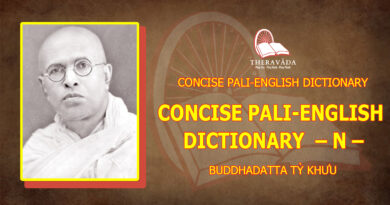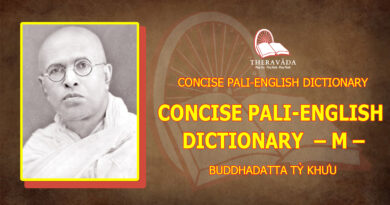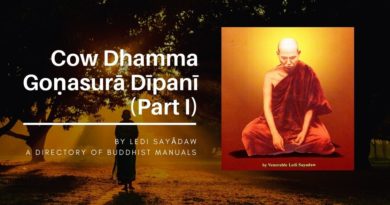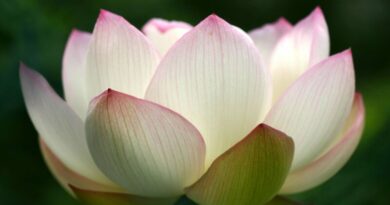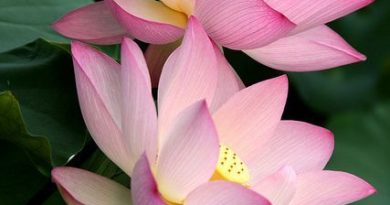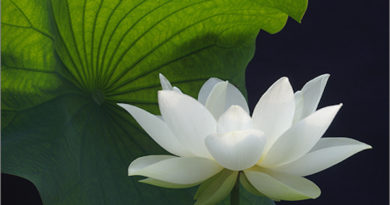VIPASSANA MEDITATION – CHAPTER 7: THE FIVE FACTORS OF A MEDITATOR
MAIN CONTENT
VIPASSANA MEDITATION – CHAPTER 7: THE FIVE FACTORS OF A MEDITATOR
In order that a meditator can make progress in his insight meditation, he must have five factors.
The First Factor is faith. A meditator must have a firm and strong faith in the Buddha, Dhamma and Sangha, especially in the Dhamma which includes the technique of meditation he is practising.
The Second Factor is, he must be healthy both mentally and physically. If he suffers from headaches, reels dizzy or has stomach trouble, gastric or any other illness, it does not mean he is not healthy. He is considered to be healthy to the extent that he can observe any mental or physical process. The food he takes must be digestible (i.e. food which does not cause stomach disorders) because if he suffers from indigestion, he will not be able to practise very well.
The Third Factor is he must be honest and straight forward. That means he must not tell lies to his teacher or to his fellow meditators. Honesty is the best policy.
The Fourth Factor is energy (uiriya) – not ordinary energy but unwavering, strong and firm energy (padhana). A meditator must have this factor for his success in striving for emancipation. He should never let his uiriya or effort decrease, but should be perpetually improving or increasing it. When viriya or padhana is increasing, then mindfulness will become continuous, constant and uninterrupted. When mindfulness becomes continuous, constant and uninterrupted, concentration will become deep and strong. Insight will become sharp and penetrative, resulting in the clear comprehension of the mental and physical processes in their true nature.
The Fifth Factor is pannaor wisdom. Though we use the word pannait does not refer to ordinary pannaor knowledge. It refers to insight knowledge of the arising and passing away of nama and rupa (udayabbaya nana) which is the fourth stage of insight knowledge. The first stage is Namarupa pariccheda nana (knowledge of the difference between mentality and physicality). The second stage is Paccayapariggaha nana(knowledge of causality or knowledge of the Law of Cause and Effect). The third is knowledge of comprehension – Samma sana nana. Know ledge of comprehension means knowledge which penetrates and comprehends all the three characteristics of mental and physical processes, namely, anicca, dukkha and anatta. The fourth stage is Udayabbaya nana knowledge of arising and passing away of mental and physical phenomena.
So the Buddha said that panna here refers to that fourth stage of insight knowledge which penetrates into the appearance and disappearance of mentality and physicality. A meditator is expected to possess this factor. In the beginning, a meditator may not possess this insight knowledge of arising and passing away. but he must strive with padhana (strong and firm viriya or effort) to meditate on mental and physical processes to attain the fourth stage of insight knowledge, i.e. Udayabbaya nana, knowledge of arising and passing away. If a meditator possesses wisdom he is sure to make progress until he attains at least the lowest Path Knowledge – Sotapatti magga nana. That is why the Buddha said that a meditator must possess wisdom which realises the appearance and disappearance of mental and physical phenomena. So these are the five factors which a meditator must have.
When a meditator has attained Sotapatti magga nana, the first stage of enlightenment, he has uprooted both the concept of a soul or a self, personality or individuality (sakkaya ditthi) and doubt (vicikiccha) about the Triple Gem. When a meditator has attained purification of mind, his mind becomes sharp enough to penetrate into the true nature of the mind body processes. Then he distinguishes between the mental and physical processes and realises the specific characteristics of mental and physical phenomena. This is the first stage of insight. When he can realise the specific characteristics of mental and physical phenomena and can distinguish between nama and rupa, he can destroy sakkaya ditthi and atta ditthi for the time being. At this stage of insight, he has uprooted sakkaya ditthi and atta ditthi. When he is not experiencing this insight, sakkaya ditthi and atta ditthi will come back to him, although not strongly. Sakkaya ditthi is only uprooted or exterminated by attaining the first stage of enlightenment, Sotapatti magga- nana.
Part 1 – Atta In Brahmanism
We should understand the concepts of sakkaya ditthi and atta ditthi from the point of view of Hinduism.
According to Hinduism or Brahmanism, the whole world was created by Mahabrahma. This Mahabrahmahas many names such as, Isvara, Paramatmaand Prajapati. Pati means creator or master. Prajameans creatures or living beings. So he is the master of living beings because he created them.
Paramatma is a Sanskrit or Hindu term. In Pali it is Paramatta. When wedivide this Paramatma into two words, it is Parama and atma. Here parama means the noblest, the holiest; atma means soul or self. So Paramatma means the holiest soul. Some translate this word as the big self or big soul. This soul is big enough to create the world and living beings. When the condition of the world was good enough for living beings to live in, he created all living beings- men, decas, Brahmas,and animals. He even created tigers, lions and poisonous snakes, which are a great danger to man. When Mahabrahma or Paramatma first created living beings, they were like corpses; they could not move, sit or stand. Then Mahabrahma wanted to make these creatures come to life. So he put a soul into each creature or living being. Then all the creatures got up and moved, stood, sat and so on. In this way, that small soul or self existed in every living being according to Brahmanism. Even an insect has a small soul in it. That soul is called Jiva atta. It is everlasting and indestructible and cannot he destroyed by any means, even an atomic bomb, because it is supported by Mahabrahma or Prajapati. But when this body is about to disintegrate, that soul knows that the body is about to disintegrate – so it has to be prepared to leave that body and reincarnate into another body. It has to take existence either in a lower or higher world, depending on its kamma in this life. If that soul performs meritorious deeds in this life, these meritorious deeds are good kamma so they lead the soul to a higher level of existence. When the soul reincarnates into another body, we call it reincarnation. But that everlasting soul, jiva atta or self cannot be destroyed in the next existence either. So the cycle of reincarnation continues.. This is what Brahmanism believes about soul. In short. according to Brahmanism, there is an everlasting entity in us, the so called self, soul or ego.
That belief or concept of an everlasting entity, soul, self or ego, known as Atta ditthi, is due to the non realisation of the true nature of the natural processes.
Part 2 – Attta In Buddhism
We are not Hindus but we have the concept of a soul, though the concept is not so strong because we follow the doctrine of the Buddha. We understand theoretically that there is no soul or self or that there is no everlasting entity, yet we believe that when a person dies, the soul comes out of the body and stays near his house or his corpse or his coffin. It Is a common belief that if we do not make offerings to the monks (bhikkhu ) and have not shared our meritorious deeds with the departed ones, the soul has to live around us.
Though we believe the doctrine of the Buddha, we still have this concept of atta ditthi, and based on this concept we have another concept of personality, individuality, a being, a man or a woman -sakkaya ditthi (sakkaya here means nama and rupa, ditthi means wrong or false view). We have this concept because we do not comprehend the specific and common characteristics of the mind body processes; we take them to be everlasting.
If you ask yourself, “Will I die tomorrow?” – you dare not answer the question. If I say you are going to die tomorrow, you will get angry with me because you have the idea of permanency of mental and physical processes. You think your mind body processes are permanent; at least until tomorrow. Yes, that is the idea of permanency. You hold it because you have not realised the appearance and disappearance of the process of mental and physical phenomena. If you see the constant, instant appearance and disappearance of mental and physical phenomena, you will not believe them to be permanent.
Theoretically you understand that none of the mental and physical processes last even a second according to the doctrine of the Lord Buddha, but practically you do not believe it because you have not realised their impermanent nature. Only if you have personal experience of the Dhamma, do you conclude that it is impermanent. You can then accept, “I may not even live until tomorrow. I may die this very second because every phenomena is subject to impermanence Actually, when a man has not realised the arising and passing away of mental arid physical phenomena, he takes them to be permanent. The idea of personality is based on the belief in a permanent entity within us. So atta ditthi and sakkaya ditthi are the same.
If we say, “Now I am lifting my hand”, then you ask me who is lifting the hand. I will say, “I am lifting the hand.” Who is that I? A bhikkhu, a man, or a being who is living? If we do not believe in the permanent nature of mind body processes, we do not take them to be a being. But actually, the dual process of mentality and physicality which constitutes a so called person is subject to change, arising and passing away but we do not realise it. We take this dual process to be a person, a being, a dog or an animal. This view is called sakkaya ditthi. Unless we can rightly comprehend these mind and body processes in their true nature we are unable to overcome or destroy this false view.
That is why the Buddha teaches us to be mindful of any activity of mind and body, or any mental and physical processes as they really are, so that we can realise the two processes as natural processes. This insight is called knowledge of Sabhava lakkhana (right understanding of the specific characteristics or individual characteristics of mental and physical phenomena). This insight knowledge destroys the concept of soul or self, person or being which is the main cause of defilements (kilesas) such as greed, anger, delusion and conceit and so on. So we can say that this concept of a soul or a self is the seed of all defilements. When we have exterminated the seed there will not arise any defilements and we have got rid of suffering. That is:
Sakkaya ditthi pahanaya sato bhikkhu paribbaje.
Sakkaya ditthi pahanaya means to overcome this false view of a soul, a self or a person; sato means mindful; bhikkhu means monk. A bhikkhu who is mindful of phenomena must strive or practise to overcome the false view. When he is able to destroy that sakkaya ditthi, he is sure to deliver himself from all kinds of suffering. This sakkaya ditthi is the cause of all kinds of defilements or the seed of all defilements. So we have to try to exterminate it through right understanding of mental and physical processes by means of mindfulness meditation.
May all of you practise this mindfulness meditation strenuously and attain the cessation of suffering.
Sadhu! …..Sadhu!…..Sadhu!


